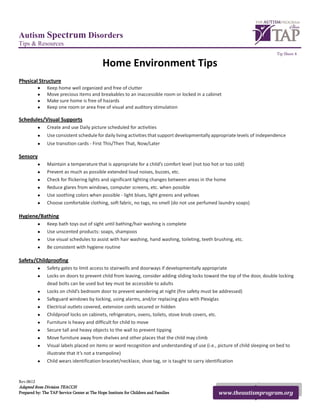
TAP Tip Sheet - Home Environment Tips
- 1. Autism Spectrum Disorders Tips & Resources Tip Sheet 4 Home Environment Tips Physical Structure • Keep home well organized and free of clutter • Move precious items and breakables to an inaccessible room or locked in a cabinet • Make sure home is free of hazards • Keep one room or area free of visual and auditory stimulation Schedules/Visual Supports • Create and use Daily picture scheduled for activities • Use consistent schedule for daily living activities that support developmentally appropriate levels of independence • Use transition cards - First This/Then That, Now/Later Sensory • Maintain a temperature that is appropriate for a child’s comfort level (not too hot or too cold) • Prevent as much as possible extended loud noises, buzzes, etc. • Check for flickering lights and significant lighting changes between areas in the home • Reduce glares from windows, computer screens, etc. when possible • Use soothing colors when possible - light blues, light greens and yellows • Choose comfortable clothing, soft fabric, no tags, no smell (do not use perfumed laundry soaps) Hygiene/Bathing • Keep bath toys out of sight until bathing/hair washing is complete • Use unscented products: soaps, shampoos • Use visual schedules to assist with hair washing, hand washing, toileting, teeth brushing, etc. • Be consistent with hygiene routine Safety/Childproofing • Safety gates to limit access to stairwells and doorways if developmentally appropriate • Locks on doors to prevent child from leaving, consider adding sliding locks toward the top of the door, double locking dead bolts can be used but key must be accessible to adults • Locks on child’s bedroom door to prevent wandering at night (fire safety must be addressed) • Safeguard windows by locking, using alarms, and/or replacing glass with Plexiglas • Electrical outlets covered, extension cords secured or hidden • Childproof locks on cabinets, refrigerators, ovens, toilets, stove knob covers, etc. • Furniture is heavy and difficult for child to move • Secure tall and heavy objects to the wall to prevent tipping • Move furniture away from shelves and other places that the child may climb • Visual labels placed on items or word recognition and understanding of use (i.e., picture of child sleeping on bed to illustrate that it’s not a trampoline) • Child wears identification bracelet/necklace, shoe tag, or is taught to carry identification Rev.0612 Adapted from Division TEACCH Prepared by: The TAP Service Center at The Hope Institute for Children and Families www.theautismprogram.org
